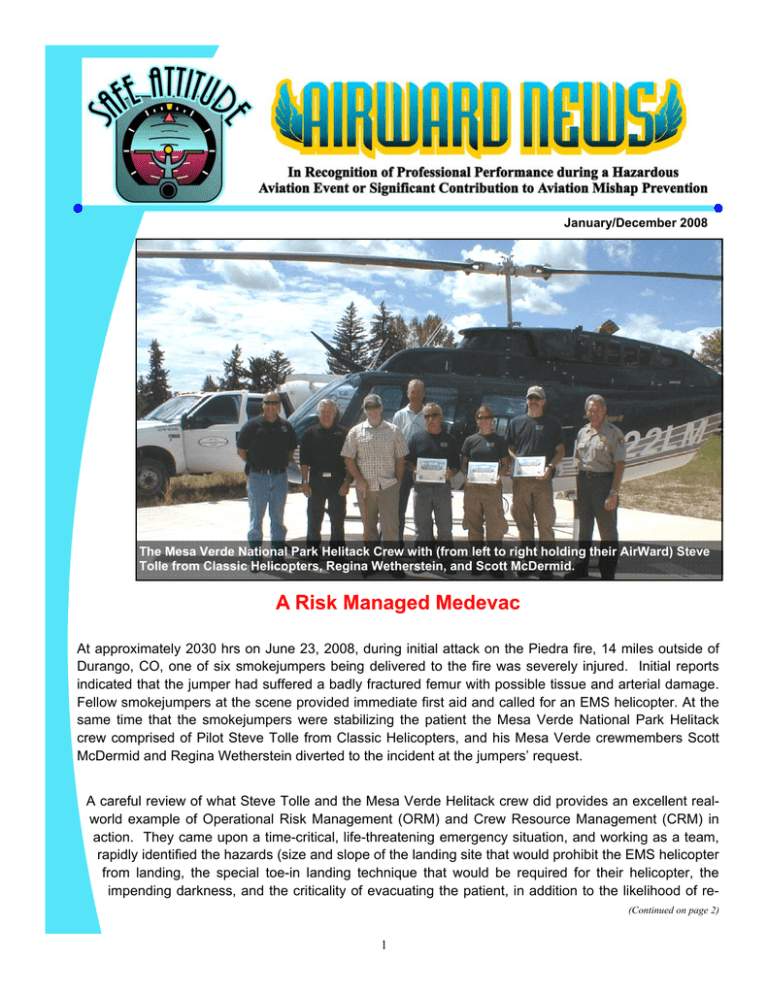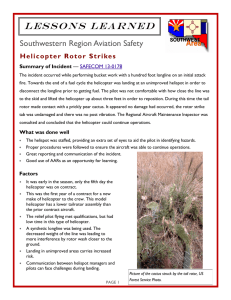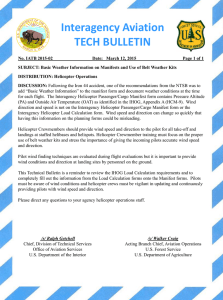January/December 2008 Tolle from Classic Helicopters, Regina Wetherstein, and Scott McDermid.
advertisement

January/December 2008 The Mesa Verde National Park Helitack Crew with (from left to right holding their AirWard) Steve Tolle from Classic Helicopters, Regina Wetherstein, and Scott McDermid. A Risk Managed Medevac At approximately 2030 hrs on June 23, 2008, during initial attack on the Piedra fire, 14 miles outside of Durango, CO, one of six smokejumpers being delivered to the fire was severely injured. Initial reports indicated that the jumper had suffered a badly fractured femur with possible tissue and arterial damage. Fellow smokejumpers at the scene provided immediate first aid and called for an EMS helicopter. At the same time that the smokejumpers were stabilizing the patient the Mesa Verde National Park Helitack crew comprised of Pilot Steve Tolle from Classic Helicopters, and his Mesa Verde crewmembers Scott McDermid and Regina Wetherstein diverted to the incident at the jumpers’ request. A careful review of what Steve Tolle and the Mesa Verde Helitack crew did provides an excellent realworld example of Operational Risk Management (ORM) and Crew Resource Management (CRM) in action. They came upon a time-critical, life-threatening emergency situation, and working as a team, rapidly identified the hazards (size and slope of the landing site that would prohibit the EMS helicopter from landing, the special toe-in landing technique that would be required for their helicopter, the impending darkness, and the criticality of evacuating the patient, in addition to the likelihood of re(Continued on page 2) 1 (Continued from page 1) ceiving scrutiny for violating policy). They also weighed these risks against the benefits of doing the mission themselves (getting the seriously injured jumper out of the field and to a hospital in daylight instead of waiting until after dark to attempt the extrication when the risks to the helicopter and the patient would be greater). The Department does not normally condone deviating from policy (without proper approval through the chain of command). However, in this case the people on the scene with the best knowledge of the tactical situation (both the aircrew and the smokejumpers on the ground) thoroughly identified the hazards, evaluated the risks, and developed a plan to minimize those risks. Throughout this process the known risks and policy deviations were discussed between the pilot, the helicopter manager, the helitack crew back at the helibase, and the smokejumpers at the site. Then, and only then, an informed decision to accept those risks was made based on the judgment that the benefits far outweighed the risks. When the mission was finished the crew conducted an extensive after action review, the Regional Aviation Manager was notified, and a SAFECOM outlining the entire process, to include policy deviations, was filed. Altogether, this is exactly the type of initiative, tempered with appropriate communications, crew coordination, and risk management that distinguishes the very best crews, and it is why the Department of the Interior is proud to recognize Steve Tolle, Scott McDermid, and Regina Wetherstein for their outstanding efforts with AirWards. SAFECOM 08-0382 Thorough Pre-flight Pays Off Pilot in Command Carl Squires of Airwest Helicopters made a substantial contribution to aviation safety while working on the Apache-Sitgreaves NF in Arizona. On April 26, 2008, during the morning preflight of his Bell 206 L-4 helicopter, Carl noticed unusual wear on the output shaft of the tail rotor. Subsequent inspections revealed grooves in the output shaft that were caused by worn tail rotor crosshead splines pitching up and down. Damage was well beyond allowable tolerances for this shaft and could have resulted in catastrophic loss of the helicopter and crew had Carl not been vigilant in his preflight duties. Jami Anzalone and Carl Squires Carl’s leadership and efforts in promoting a culture of aviation safety are recognized nationally through the AirWard program. Thanks Carl, good eye. SAFECOM 08-0182 2 Networking and Pro-Active Maintenance Prevents an Accident On the evening of July 20, 2008, Papillion Grand Canyon Helicopters’ mechanic Richard Gibson received a call from a friend with CalStar Air Ambulance Service out of California about a hard landing that occurred to one of their MD 902s. The investigation of the CalStar mishap identified a fractured Forward Directional Control Cable (FDCC) on the mishap aircraft and a cracked FDCC mounting bracket on another aircraft. Jay Lusher and Richard Gibson Richard knew that the FDCC is used to control the thruster cone of the NOTAR (anti-torque) system on the MD902 and a failure of the FDCC would cause the pilot to lose directional control. He also knew that the failure of another NOTAR system component had caused the Park’s helicopter to crash on October 16, 2003. The next day, in coordination with the Park’s Helicopter Program Manager, Richard inspected the FDCC and the mounting bracket on the Park’s helicopter and found the mounting bracket cracked. Richard placed the helicopter out of service and notified the As a direct result of network- manufacturer, MD Helicopters, Inc. (MDHI). The technical ing and pro-active intervenstaff at MD Helicopters suggested that the FDCC might have tion by Richard Gibson and been affected by the cracked mounting bracket and recomhis friends at CalStar and MD mended that it be replaced. Inspection at the factory confirmed that the FDCC was in fact faulty too. MD Helicopters Helicopters another accident has since published a Service Bulletin to address installation was prevented. and inspection procedures for the FDCC system. According to the folks at the Grand Canyon this is just what Richard does, day in and day out. The Park’s Helicopter Program Manager summed it up perfectly saying, “Richard often goes above and beyond when it comes to maintenance of our aircraft, and the safety of our flight crews is always the utmost concern for him… This is not the first time Richard has performed additional inspections to ensure that the aircraft is in top condition for use. Richard has also never been intimidated to return an aircraft to service before it is ready, safety is always a higher concern of his over a revenue flight… I am proud to have such a competent and safety-minded mechanic on our contract and would fly on any aircraft that he maintains any day.” For always going the extra mile to ensure the safety of his aircraft and passengers the Department of the Interior is proud to recognize Richard Gibson with an AirWard. Well done Richard!!! SAFECOM 08-0857 3 H-516 to the Rescue On June 26, 2007, two firefighters deployed their fire shelters during a period of intense fire behavior in their division on the Angora Fire. During their deployment they were able to make radio contact and guide a Forest Service contract helicopter to their location. The conditions during this time were very smoky with winds gusting up to 20 MPH. The pilots did an outstanding job in keeping the firefighters calm and advised of the situation. The Big Hill Helitack ship, piloted by Phil Ketek and Doug Riggs responded to the firefighters request for assistance. The pilots did an outstanding job in keeping the firefighters calm and advised of the situation. They made the first water drop and were instrumental in coordinating three other Type 1 helicopters to the deployment location. The four helicopters dropped water continuously for over one hour in a smoky/windy flying environment. The water drops continued to improve the conditions in the area of the deployment until two Safety Officers were able to walk to their location. The firefighters were found in good condition and were able to walk out on their own. Phil and Doug from Helimax Aviation are commended for an outstanding job in a very stressful situation. Thanks Phil and Doug, great job. Doug Riggs and Phil Ketek 4 AIRMANSHIP, COMMUNICATION and COORDINATION pays off….. Airmanship, communication, and coordination were all executed so well during this mishap that it played a significant role in keeping a bad situation from turning into a disaster. During a forest recon on the Payette NF the Cessna 206 experienced an engine failure from a faulty oil pump. The pilot, John Ugland with McCall Aviation, is commended for his extraordinary airmanship in dealing with the in-flight emergency and forced landing. Rick Belknap the ATGS/observer did an outstanding job John Ugland and Rick Belknap. Not pictured managing radio communications with the lookout at Derek McLaughlin and Ann Nicholson. Horse Mountain. Derek McLaughlin, the lookout was exceptional in relaying information between the aircraft and Payette dispatch. Ann Nicholson, the dispatcher on the Payette NF, did an excellent job diverting a helicopter with EMTs aboard from another mission to the mishap site quickly and then making all the proper notifications. Everyone involved in this event stayed calm, cool and showed a great deal of teamwork under stress. Thanks to all of you for a job well done. SAFECOM 07-0552 Great Catch Sergeant During the annual Modular Airmechanics to inspect the borne Firefighting System mechanism. The MAFFS me(MAFFS) recertification training chanics found a second bushing at Channel Islands Air National to also be cracked upon thorGuard Station, Port Hueneme, ough inspection and replaced California, Technical Sergeant both bushings with the bushings Brandon B. York discovered infrom the spare MAFFS tank. All flight, a crack in the butterfly subsequent training flights were valve shaft bushing that could temporarily halted in the loading have lead to a possible mepits until a visual inspection was chanical failure of the MAFFS completed. Sergeant York is an tank. His vigilance and high experienced MAFFS loadmaster level of duty and responsibility Technical Sergeant Brandon B. York based at Cheyenne, Wyoming prevented a possible failure of (153rd Airlift Wing Wyoming Nathe controls which release the pressurized load tional Guard). of water (3000 gallons) contained in the tank. After landing Sergeant York notified the Chief Nice job and a big Thanks Sergeant York. Loadmaster who called for the MAFFS SAFECOM 08-0202 5 Seconds from Disaster On July 15, 2008, the 400-acre Gooding Gun Club Fire, which was being pushed by west-southwesterly winds in rolling desert terrain, was being supported by an air attack aircraft, three single engine airtankers (SEATs), and two helicopters when one of those “tooclose-for-comfort moments” occurred. The SEATs were working along the north flank of the fire and the helicopters were also on the north flank, one on the west end and one on the east end. Just after a transition from the original aerial supervisor to the relief aerial supervisor, the new ATGS sized John Mills Joe Rogan up the situation and saw both helicopters moving off to their dip sites and that there was a gap in the lines that one of the SEATs could handle. The ATGS intended to call both helicopter pilots to hold at their dip sites so that the SEAT drop could be made. Everything was going according to plan except for one very simple mistake; the ATGS had used the call sign of the helicopter on the west end when he intended to talk to the helicopter on the east end of the north flank. As a result, the helicopter on the west end acknowledged the command to hold, but the helicopter on the east end continued onward to his helitack crew along the east end of the north flank. At the same time the SEAT pilot, assuming that the line was clear, continued onward to make the directed drop. No one in any of the cockpits recognized the impending disaster. Fortunately, Joe Rogan, assistant foreman for Boise Helitack, and the lead crewman for the helicopter on the east end, sensed that something was wrong and without a moment’s hesitation spoke up. Here’s what Joe’s pilot had to say: I was lying in the bubble window vertical referencing with a hundred foot long line, preparing to release my water. At this point, over Air to Ground on the radio, I heard Joe’s shout, “Have you got that SEAT?” I instantly aborted my bucket run, started a turn to the right, which I knew to be smoke free. I also pulled my head out of the bubble window, sitting up vertically, hoping to visually acquire the SEAT, and boy did I ever! At my immediate twelve-o-clock, also in a hard right hand bank, was the biggest SEAT I have ever seen! I started my turn based solely on Joe’s transmission, before I ever saw the SEAT. This saved critical time and still we passed within a few hundred feet of each other. Joe’s hand microphone was attached to his webbing on his shoulder. In one motion he was able to transmit his warning. His experience level made for an instant assessment of the situation; two converging aircraft and the SEAT just emerging from heavy smoke. Just as important is Joe Rogan’s personal nature, as a natural leader, he took charge and transmitted his warning. We all have had occasion to wonder how we each might react at crunch time. For a while at least, Joe Rogan does not have to wonder. Sometimes pros can make their own good luck. Two lives saved by a dedicated crewmember who stayed in the game even when he was on the ground. Thanks Joe, great job !!! SAFECOM 08-0569 6 Utah BLM Wild Horse & Burro team, both past and present. Allen Carter is pictured in the center of the back row holding his AirWard. Excellent Track Record Allen Carter the founder, former owner, and pilot for Skyhawk Helicopters, Inc., has been safely and successfully flying the Wild Horse & Burro missions for the Bureau of Land Management since 1976. Our records (which only go back to 1986) indicate that Allen has over 8,300 accident/incident free flight hours in one of the most demanding and risky environments in the Department’s aviation program. If we were able to document his flight time back to 1976 Allen would probably have accumulated well over 12,000 accident free hours in those 32 years. Allen’s exemplary accident-free performance, mission after mission, is a testament to his skill and professionalism as a pilot, his attention to detail, and the excellent maintenance program of the company. The Department of the Interior, the Bureau of Land Management, and particularly the people who have had the opportunity to work with Allen over the years take great pleasure in recognizing his contribution to the Department’s aviation program and express our thanks to him for a job well done! We’ve Got it Wired On July 22, 2008, Ben Garthwait and Zane Muhonen were riding in the backseat of N206GH as part of a helitack crew from Moab, Utah. The pilot and helicopter manager were in search of an adequate dipsite from which to support a Wildland Urban Interface (WUI) fire. Both the pilot and the helicopter manager were “heads down” looking at the river when Ben and Zane saw that the helicopter was headed directly toward a set of power lines. Ben keyed the ICS just a fraction of a second before Zane and called “POWER LINES.” The pilot instantly responded by initiating a climbing left turn. The pilot estimated that he missed the power lines by approximately 150 feet. The power lines were difficult to see since they did not have any high visibility markers. Ben and Zane’s professionalism and diligence were instrumental in preventing an aircraft accident and is deserving of a Department of the Interior AirWard. SAFECOM 08-0611 7 Heads-Up Intervention Prevents Possible Collision On July 2, 2008, Mr. Mike Creasy, a pilot with Helo Air, Inc., was flying a Bell 206L-3 in support of the U.S. Fish and Wildlife Service (FWS) on the South One Fire near Suffolk, VA. At approximately 1330 Mike was approaching the Suffolk Executive Airport from the southeast with the intent to land at the helibase on the west side of the field. Because Suffolk Executive Airport is “uncontrolled” there was no air traffic control tower to direct aircraft and it is the pilot’s responsibility to provide their own sequencing and separation. Mike, following proper procedures, made a call to trafPilot Mike Creasy fic in the area announcing his intentions when he was 5 miles out and heard a Cessna Citation call inbound for landing. The Citation was west of the airfield and stated his intent to fly a left-hand pattern and land on runway 25. Mike kept an eye out for the Citation and continued inbound. When the Citation reported left base for runway 25 Mike replied that he didn’t see the Citation and increased his visual search. At this point Mike heard another Cessna report that he was Mike immediately recognized back taxiing on runway 22 for takeoff on runway 25. Mike the potential conflict between immediately recognized the potential conflict between the airthe aircraft taxiing to runway craft taxiing to runway 25 and the Citation intending to land 25 and the Citation intending on runway 25. When Mike finally spotted the Citation he was to land on runway 25. on short final to the helibase but it appeared to him that the Citation was not aligned with runway 25 but rather runway 22 the same runway that the Cessna was back taxiing on. Mike immediately informed the Citation pilot that he needed to execute a go-around and at the same time Mike took his own evasive actions to clear runway 22. After they were all safely on the ground the Citation pilot told Mike that Norfolk Approach Control had vectored them to the wrong runway. Regardless of how the Citation got aligned with runway 22 it’s clear that Mike’s alertness, initiative, and situational awareness prevented a very dangerous situation and quite likely saved several lives. Thanks Mike for stepping up, taking action, and saving the day. Aviation Safety Offices http://www.fs.fed.us/fire/av_safety/ - http://amd.nbc.gov/safety/ 8






